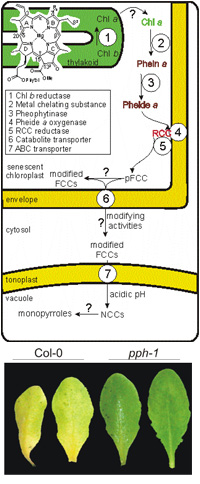Navigation auf uzh.ch
Navigation auf uzh.ch

Chlorophyll breakdown is embedded in the final developmental stage of leaf development, called senescence, which aims at remobilization of leaf nutrients, such as nitrogen. During senescence, chlorophyll-binding proteins, containing a significant amount of cellular nitrogen, are degraded with the consequence of release of chlorophyll. Due to its light-absorbing properties, free chlorophyll would have cell toxic effects and, therefore, plants require a mechanism to convert chlorophyll to non-colored, i.e. non excitable, breakdown products termed NCCs. Thus, chlorophyll breakdown can be considered as a detoxification process.
The aim of our research is to elucidate the steps of chlorophyll breakdown in higher plants. The pathway consists of several common and species-specific reactions. Breakdown starts with the removal of Mg and the hydrophobic phytol chain, yielding pheophorbide a. A key step is the subsequent loss of green color catalyzed by the joint action of two enzymes, pheophorbide a oxygenase (PAO) and red chlorophyll catabolite reductase (RCCR). Thereby pheophorbide a is converted to a fluorescent catabolite (pFCC). Genes of PAO and RCCR have been identified recently in our lab: PAO is a Rieske-type oxygenase of the chloroplast envelope; RCCR is a soluble reductase that is located in the stroma. Mutants in either PAO (pao1) or RCCR (acd2) develop a light-dependent leaf lesion mimic phenotype, which is caused by the accumulation of the respective photodynamic intermediates, pheophorbide a and red chlorophyll catabolite.
The different subcellular localization of chlorophyll and NCCs implicates the activity of catabolite transport systems at the chloroplast envelope and the tonoplast. This transport is ATP-dependent and likely mediated by members of the ABC family of transporters. Our goal is to identify and analyze transporter candidates for catabolite export from the chloroplast.
Chlorophyllase catalyzing the hydrolysis of chlorophyll to chlorophyllide and phytol had been implicated in chlorophyll breakdown. We could recently show that chlorophyllase is not required. Instead, the phytol hydrolyzing activity is carried out on Mg-free chlorophyll (pheophytin) by a new protein termed pheophytinase (PPH). As a consequence, the order of early breakdown reactions is changed, i.e. Mg release occurs before dephytylation.
Stay-green mutants that are defective in chlorophyll breakdown have been identified in several species, among them Festuca pratensis Bf993 and the green cotyledon pea mutant (I locus) analyzed by Gregor Mendel. The Festuca mutation was cloned and stay-green gene homologs (SGR) identified in Arabidopsis. In pea, SGR is identical to Mendel’s I locus. A linkage between SGR and PAO had been proposed. Re-analyzing PAO activity and pheophorbide a accumulation in sgr mutants, and silencing SGR expression in pao1, shows that SGR functions upstream and independent of PAO. Yet, the exact function of SGR remains to be elucidated.